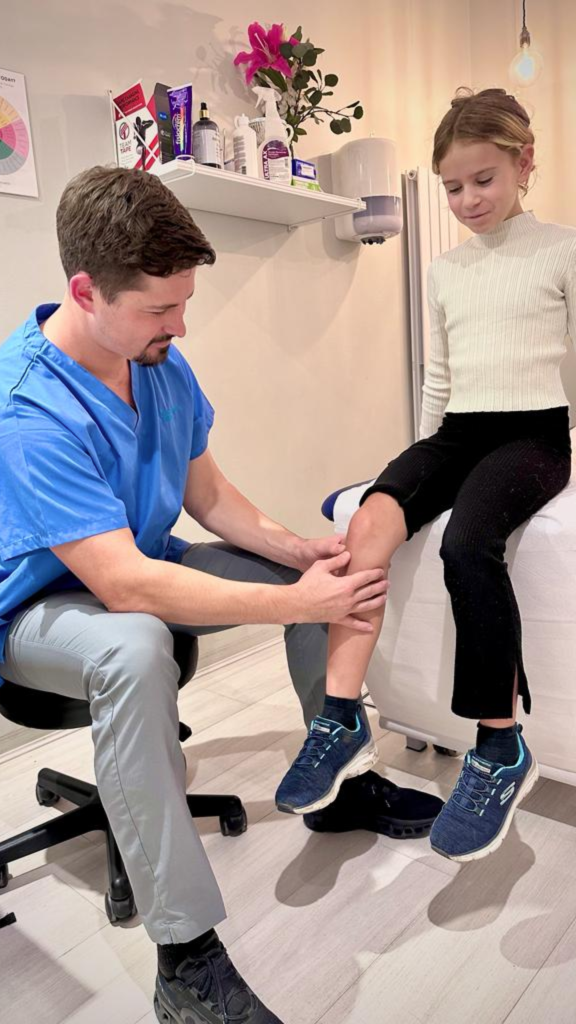
Osgood-Schlatter disease frequently emerges in children and adolescents who are in the midst of growth spurts during puberty. This condition manifests as inflammation at the tibial tuberosity, which is the prominent bump just below the knee, where the patellar (kneecap) tendon attaches. It’s particularly common among children who participate in sports requiring running, jumping, and swift directional changes. Our goal in this article is to provide parents with an understanding of Osgood-Schlatter disease in children, focusing on its typical symptoms and the available treatment options. Plus we answer your most commonly asked questions.
The most common symptom of Osgood-Schlatter is knee pain just below the kneecap. This pain can range from mild to severe and is often exacerbated by physical activities like running, jumping, or going up and down stairs.
The area may also be swollen and tender to the touch, and sometimes, a visible bump may appear.
The symptoms can occur in one or both knees and can last for several months. It’s crucial to pay attention to these signs, as early intervention can make a significant difference in treatment and recovery.
1. Rest and Activity Modification:
The first line of treatment usually involves reducing activities that trigger the pain.
2. Ice Application: Applying ice to the affected area can help reduce inflammation and provide some relief from pain.
3. Pain Relief: Over-the-counter pain medications like ibuprofen can be used to manage pain, but it’s essential to consult a healthcare provider for the correct dosage.
4. Physical Therapy: Exercises that strengthen the quadriceps can help alleviate the symptoms.
At Nordic Balance, we often encounter concerned parents with questions about Osgood-Schlatter disease, a common condition affecting growing children, especially those active in sports. This condition, characterized by pain and inflammation just below the knee, raises several questions. Does it go away on its own? What causes flare-ups? Understanding these aspects is crucial for managing your child’s comfort and activity levels. Our team of experienced physiotherapists, chiropractors, and osteopaths is here to provide insights and tailored treatments, ensuring your child navigates this growth phase with ease and confidence.
Does Osgood-Schlatter Go Away?
Yes, in most cases, Osgood-Schlatter does go away on its own, especially after the child has gone through a growth spurt. However, symptoms can last for several months or even years in some cases.
Why Does Osgood-Schlatter Flare Up?
The condition often flares up during periods of rapid growth or increased physical activity. The tension from the quadriceps muscle gets transferred to the tibial tuberosity, causing pain and inflammation.
How long does it take for Osgood to heal?
Can you still play sports with Osgood-Schlatter?
Yes, many children with Osgood-Schlatter disease can continue to play sports, but it’s important to approach this with care. The key is to manage the condition effectively to minimize pain and prevent further aggravation. Here are some tips:
Pain Management: Listen to the body’s pain signals. If playing sports causes significant discomfort, it might be necessary to reduce the intensity or frequency of the activity.
Modify Activities: Consider modifying sports activities to reduce stress on the knees. For instance, limit jumping or sprinting if these actions exacerbate pain.
Proper Warm-Up and Cool-Down: Engaging in proper warm-up exercises before sports and cool-down stretches afterward can help alleviate symptoms.
Use Supportive Gear: Knee braces or straps can provide additional support to the affected area and may help reduce pain during activity.
Rest and Recovery: Ensure adequate rest between sports activities to allow the inflamed area to recover.
Seek Professional Advice: Consult with a healthcare professional, such as a physiotherapist, for personalised advice and exercises that can strengthen the surrounding muscles without overstraining the knee.
Remember, each child’s experience with Osgood-Schlatter disease can be different, so it’s important to tailor the approach based on individual symptoms and response to activity.
Osgood-Schlatter is a common but manageable condition often seen in active, growing children. While it can be painful and limiting, the good news is that most kids grow out of it. However, early diagnosis and appropriate treatment can make the journey a lot more comfortable.
Nordic Balance offers 5-star-rated physiotherapy clinics in Battersea, Clapham, Wimbledon and St James’s, Central London. For more information about our range of injury recovery and prevention treatments, including physiotherapy, osteopathy, chiropractic, podiatry, and sports massage, call us on 0208 090 0043.
September 17th 2019
Written by a href https wimbledon nordicbalance co uk people noemi-panella target blank rel noopener Noemi Panella Osteopath D O M OSt a nbsp Flat Head Syndrome or plagiocephaly to give it its technical name is a very common condition which often occurs in newborns nbsp As new parents we...
READ MORESeptember 17th 2019
p When walking into our span style text-decoration underline span style color ff text-decoration underline a style color ff text-decoration underline href https stjames nordicbalance co uk gym-membership target blank rel noopener gym in St James's a span span you will find that like most gyms there is a weights...
READ MORESeptember 17th 2019
activecampaign form css span style font-weight The average age for Menopause in the UK is with of women going through Menopause from - and before the age of It may sound daunting but Menopause is a normal and natural part of women s lives Understanding the span strong stages of...
READ MORE